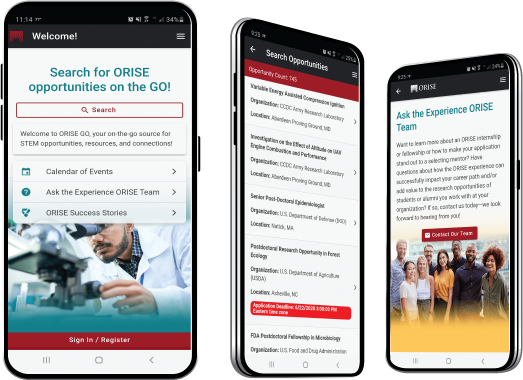Modeling Atmospheric Sulfur Chemistry
A complete application consists of:
- An application
- Transcript(s) – For this opportunity, an unofficial transcript or copy of the student academic records printed by the applicant or by academic advisors from internal institution systems may be submitted. All transcripts must be in English or include an official English translation. Click here for detailed information about acceptable transcripts.
- A current resume/CV, including academic history, employment history, relevant experiences, and publication list
- Two educational or professional reocmmendations
All documents must be in English or include an official English translation.
If you have questions, send an email to EPArpp@orau.org. Please include the reference code for this opportunity in your email.
*Applications will be reviewed on a rolling-basis.
A research opportunity is currently available at the Environmental Protection Agency (EPA), Office of Research and Development (ORD), Center for Environmental Measurement and Modeling (CEMM), located in Research Triangle Park, North Carolina. EPA ORD recently reorganized and this is the newly named Center. This was formerly NERL/IO.
During cold and dark wintertime conditions, Fairbanks, Alaska, faces a serious particulate pollution problem, violating National Ambient Air Quality Standards (NAAQS) set to protect human health. In the Fairbanks area, particulate matter (PM) is dominated by carbon compounds and sulfate, and these species can originate from both primary (i.e., directly emitted) and secondary (i.e., chemically formed in the atmosphere) sources. High PM concentrations in the region result from a combination of meteorology, chemistry, and emissions, but there remain uncertainties surrounding these high PM episodes and the best approaches to mitigate the problem.
In order to understand the evolution of chemicals in the atmosphere (and design effective control strategies for those species that may pose a threat to human and ecosystem health), three-dimensional chemical transport models (CTMs) are often used. The Community Multiscale Air Quality (CMAQ) modeling system, developed and maintained by the U.S. Environmental Protection Agency (EPA), is a state-of-the-science CTM widely used in both regulatory and research applications.
In this research project, the research participant may collaborate with a multidisciplinary team to understand the high PM problem in the Fairbanks region. The research participant may investigate potential pathways to particulate sulfur formation in the atmosphere, with a focus on those pathways that might be relevant in cold, dark wintertime conditions. This may include performing box modeling to determine promising pathways prior to implementation in CMAQ. The research participant will learn how CMAQ simulates wintertime episodes, how to design sensitivity simulations, and how to analyze the impacts of model developments. The research participant may gain experience applying instrumented versions of CMAQ with additional diagnostic capabilities like the Sulfur Tracking Method (STM).
As part of this project, the research participant will learn about:
- Chemical transport modeling, particularly the development and application of CMAQ
- Atmospheric heterogeneous sulfur chemistry
- Effectively conducting research both independently and within a diverse team of researchers
The research participant may have the opportunity to present their research through a combination of reports and technical presentations. This research may also contribute to a manuscript for submission to a peer-reviewed journal.
The mentors for this opportunity are Kathleen Fahey (fahey.kathleen@epa.gov) and Havala Pye (pye.havala@epa.gov).
Anticipated Appointment Start Date: Spring/Summer 2020
This program, administered by ORAU through its contract with the U.S. Department of Energy (DOE) to manage the Oak Ridge Institute for Science and Education (ORISE), was established through an interagency agreement between DOE and EPA. The initial appointment is for three months, but may be renewed upon recommendation of EPA and is contingent on the availability of funds. The participant will receive a monthly stipend commensurate with educational level and experience. Proof of health insurance is required for participation in this program. The appointment is full-time at EPA in the Research Triangle Park, North Carolina, area. Participants do not become employees of EPA, DOE or the program administrator, and there are no employment-related benefits.
Completion of a successful background investigation by the Office of Personnel Management (OPM) is required for an applicant to be on-boarded at EPA. OPM can complete a background investigation only for individuals, including non-US citizens, who have resided in the US for the past three years.
The qualified candidate should be currently pursuing or have received a bachelor's, master's or doctoral degree in one of the relevant fields. Degree must have been received within five years of the appointment start date.
Preferred skills:
- Experience with Fortran and scripting
- Experience with Linux
- Some knowledge of atmospheric chemistry, especially aqueous chemistry in aerosol and clouds
- Citizenship: U.S. Citizen Only
- Degree: Bachelor's Degree, Master's Degree, or Doctoral Degree received within the last 60 months or currently pursuing.
- Discipline(s):
- Veteran Status: Veterans Preference, degree received within the last 120 month(s).

 ORISE GO
ORISE GO

The ORISE GO mobile app helps you stay engaged, connected and informed during your ORISE experience – from application, to offer, through your appointment and even as an ORISE alum!





